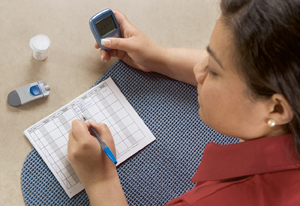Using a Blood Sugar Log
Using a Blood Sugar Log

You have diabetes. This means your body has trouble controlling blood sugar (glucose). To help manage your diabetes, check your blood sugar level as directed by your healthcare provider. Keep a log of your blood sugar levels to help you track it. It’s a simple and easy way to see how well you are controlling your diabetes.
Checking your blood sugar level
Check your blood sugar with a blood glucose meter. First, wash and dry your hands. Next, you’ll prick the side of your finger with a tiny lancet or with a spring-loaded lancing device to draw a tiny drop of blood onto a test strip.
The strip goes into the meter first. Next a drop of blood is placed on the tip of the strip. The meter shows your blood sugar level. Your readings should be in your target range as often as possible. This means not too high or too low. Staying in this range helps lower your risk for problems. Your healthcare provider will help you find the target range that is best for you.
Some glucose meters let you use another place on your body to test. But these other places should not be used in some cases as they may not be accurate. Follow the instructions for your glucose meter. And talk with your healthcare provider before doing the test on other places.
Continuous glucose monitoring
Continuous glucose monitoring (CGM) may be an option for checking your blood sugar levels. It tracks your blood sugar level throughout the day and night. This can help you make better choices about food and physical activities, and taking medicines. It can also find trends and patterns that can help your healthcare provider better manage your diabetes. Ask your healthcare provider if CGM is right for you.
Several CGM devices are available. They are approved by the FDA with a prescription from a healthcare provider. It includes a sensor, transmitter, and a receiver or monitor. The sensor is a small device placed under the skin. It will measure your blood sugar several times a minute. A transmitter sends the information to a receiver. This may be a part of an insulin pump or a separate device.
Your blood sugar will still need to be checked a few times a day with a regular glucose meter to look for accuracy. The sensor under the skin needs to be replaced every 3 to 7 days.
Tracking your readings
Record the readings in your log book or using an online app each time you check your blood sugar. Your meter may also have a memory feature. Your healthcare provider can check this at your next visit. You may be told by your healthcare provider to check your blood sugar in the morning, at bedtime, and before and after meals. Be sure to write down all of your numbers. Also use your log to record things that might have affected your blood sugar. Some examples include being sick or dehydrated. It may also include taking certain medicines, being physically active, feeling stressed, or skipping meals.
Lessons learned from your readings
Tracking your blood sugar readings helps you see patterns. This tells you how your actions affect your blood sugar. For instance, you may have higher numbers after eating certain foods. Or you may have lower numbers after exercise. This helps you understand how to stay in your target range.
Sharing your log with your healthcare team
Bring your blood sugar log and glucose meter with you to all of your appointments. This can help your healthcare team make changes to your treatment plan, if needed. This may mean making changes in what you eat, what medicines you take, or how much you exercise.
To learn more
The resources below can help you learn more:
-
American Diabetes Association, 800-342-2383, www.diabetes.org
-
Lighthouse International, 800-829-0500, www.lighthouse.org
-
National Eye Institute, 301-496-5248, www.nei.nih.gov
-
Hormone Health Network, 800-467-6663, www.hormone.org
Updated:
April 29, 2019
Reviewed By:
Robert Hurd MD,Marianne Fraser MSN RN,Raymond Kent Turley BSN MSN RN